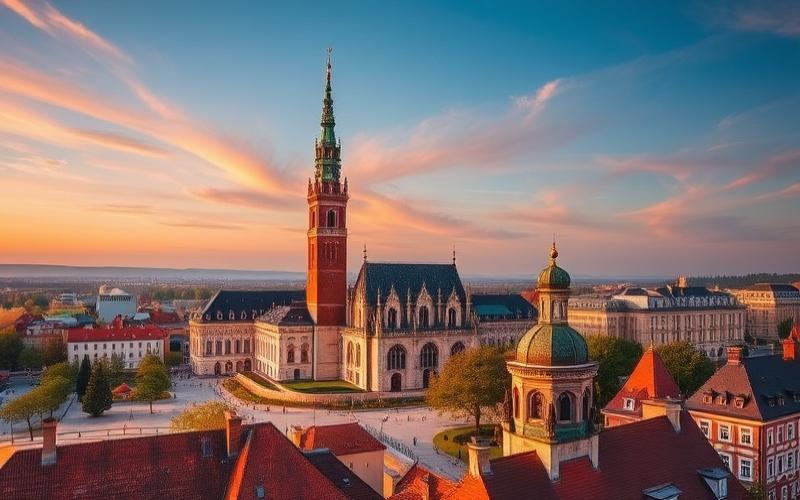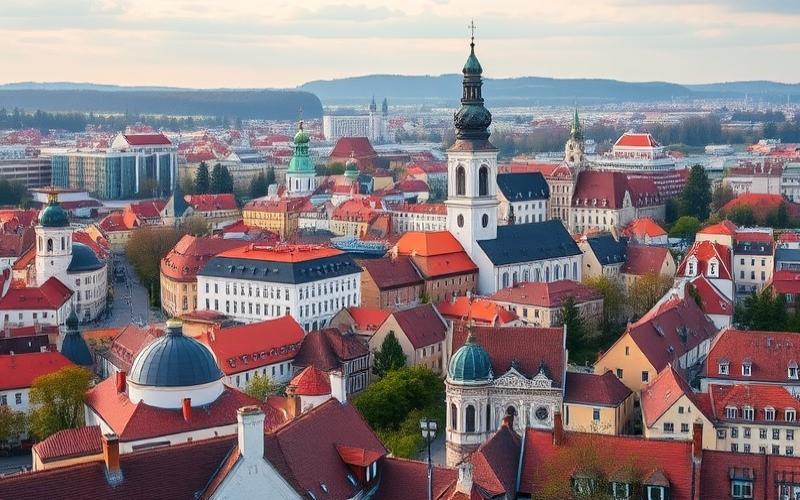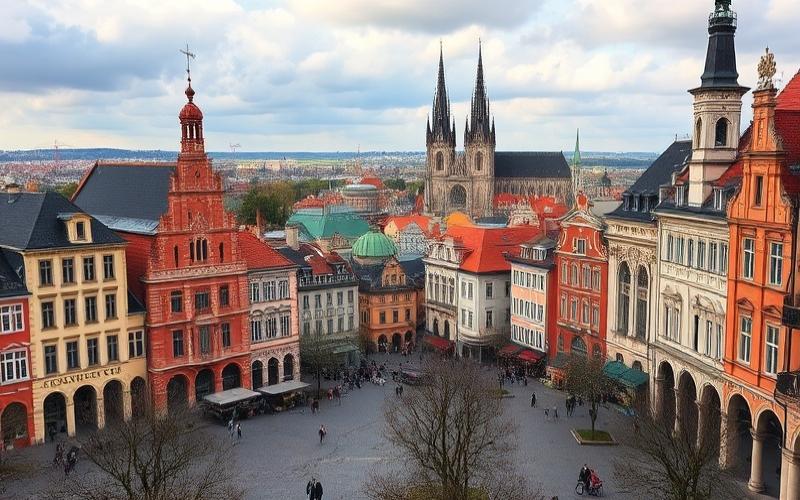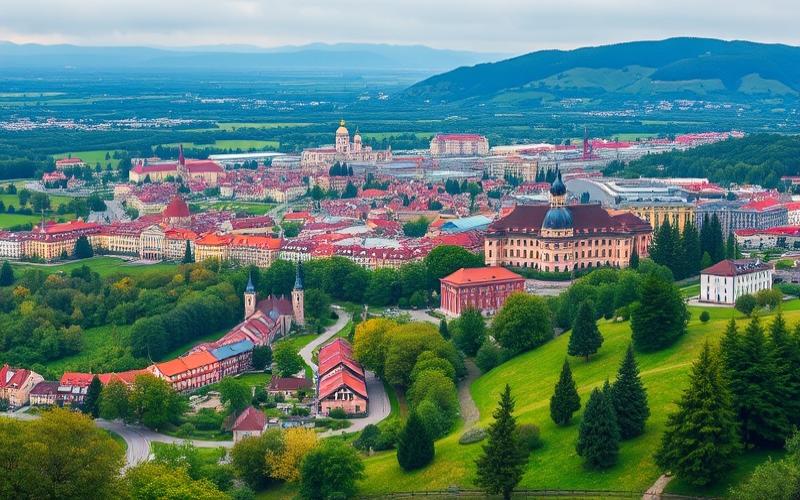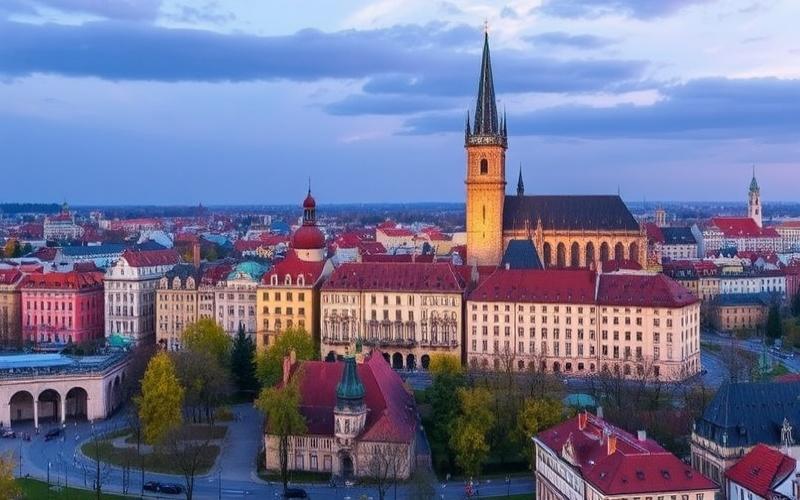
 Published on and written by Cyril Jarnias
Published on and written by Cyril Jarnias
Poland’s Real Estate Market Undergoing Transformation
At the heart of Eastern Europe, Poland’s real estate market is experiencing rapid transformation, partly triggered by the war in Ukraine.
Impact of the War in Ukraine on Demand
This article explores how this conflict has not only increased housing demand in Poland due to an influx of refugees seeking shelter, but has also influenced foreign investments, prompting many businesses and individuals to seek safe and stable opportunities.
Trends and Opportunities for Investors
Through an analysis of emerging trends and price fluctuations, we will discover how this geopolitical upheaval is redefining the local real estate landscape, while offering unique challenges and opportunities for buyers and investors.
Good to Know:
Poland has become a preferred destination for real estate investors seeking stability and attractive returns in an uncertain geopolitical context.
Geopolitical Consequences on Poland’s Real Estate Market
Recent tensions between Russia and Ukraine have profoundly altered Central Europe’s geopolitical environment, directly affecting economic and political stability in Poland. This regional instability has had significant repercussions on Poland’s real estate market, both from the perspective of foreign investors and local residential demand.
Analysis of Foreign Investors’ Risk Perception
- Perceived increase in geopolitical risk: The military escalation in the east has raised uncertainty levels for international investors, heightening their vigilance toward any investment in Poland.
- Partial redirection of investment flows: Some international capital has shifted toward markets perceived as more stable or less exposed to border risks.
- Strengthened regulatory oversight: Polish authorities have increased control over the origin and cross-border movement of funds to align real estate transactions with international requirements related to sanctions against Russia.
| Factor | Consequence for Investors |
|---|---|
| Russo-Ukrainian tensions | Increase in risk premium |
| Enhanced regulatory control | Longer purchasing process, additional verifications |
| Regional currency volatility | Frequent reassessment of expected returns |
Changes in Real Estate Demand Due to Influx of Ukrainian Refugees
The massive arrival (several million) of Ukrainian refugees since 2022 has disrupted Poland’s residential market:
- Increased rental demand in major cities (Warsaw, Krakow, Wrocław)
- Notable pressure on private and social rental housing stock
- Temporary but marked acceleration in rent and price per square meter increases
Recent Statistics
- According to several sector studies published between 2023 and 2025:
- +15 to +25% increase in average rents observed in some major urban areas at the migration peak
- Similar increase noted in certain segments of new residential properties primarily dedicated to newcomers or mobile populations
Government Measures in Response to Geopolitical Risks
Facing this unprecedented situation, the Polish government has adopted a series of initiatives:
- Direct support for temporary refugee housing, via municipal subsidies or public/private partnerships
- Temporary tax incentives to stimulate rental supply for new arrivals (tax relief for landlords under certain conditions)
- Enhanced macroprudential monitoring aimed at preventing any speculative bubble linked to a sudden influx of opportunistic or speculative investors
- Strategic diversification encouraged among national developers to avoid exclusive dependence on volatile international segments
Important Considerations
The Russo-Ukrainian war remains a central factor durably influencing not only investment strategies but also any socio-economic dynamics directly affecting Poland’s real estate sector.
This context encourages all stakeholders – both institutional and individual – to adapt their expectations regarding future developments in the local market.
Good to Know:
Russia’s invasion of Ukraine has had significant geopolitical repercussions on Poland’s real estate market, influencing foreign investors who now perceive increased risk. Consequently, some have slowed their investment activities due to fears of regional instability. The influx of Ukrainian refugees has also caused a surge in housing demand, leading to price increases in the residential sector, particularly in major cities like Warsaw and Krakow. According to a recent study, rents have increased by 15% over the past six months. To mitigate these fluctuations, the Polish government has implemented economic support measures, such as tax incentives for real estate investors and housing access programs for refugees, seeking to stabilize the market amid this geopolitical pressure.
Impact of Ukrainian Refugees on Housing in Poland
In 2024, Poland has welcomed nearly nine million Ukrainian refugees, primarily concentrated in major cities like Warsaw, Krakow, and Wrocław. This massive arrival has caused a significant increase in housing demand, leading to rising rents in urban areas.
Evolution of Ukrainian Refugee Numbers in Poland
| Year | Cumulative number having crossed the border |
| 2022 | >8 million |
| 2024 | ~9 million |
Main Geographic Distribution
- Warsaw
- Krakow
- Wrocław
- Other major urban areas
Effects on the Housing Market
- Rapid rent increases in major Polish cities.
- Higher occupancy rates in rental properties and increased pressure on the residential real estate market.
- Difficulty finding affordable housing for both refugees and some Polish households.
Government and Local Initiatives
List of measures taken:
- Establishment of reception points at the border offering temporary shelter, hot meals, and basic medical care.
- Free access to national trains (TLK and IC) to facilitate movement to different regions.
- Administrative simplification: permission to enter without valid documents or complete paperwork; rapid issuance of temporary permits.
- One-time financial support or housing subsidies for certain families hosting refugees.
Summary Table:
| Measure | Scope | Limitations/Duration |
| Emergency temporary housing | National (reception points) | Short term |
| Free transportation | National | Limited time after arrival |
| Housing assistance/subsidies | Local/National | Variable |
Challenges Faced by the Real Estate Market
- Chronic shortage of affordable rental housing facing the massive influx.
- Tension between immediate needs (temporary shelter) and sustainable solutions (stable housing).
- Temporary saturation of local social infrastructure (schools, childcare facilities).
Synthetic List:
- Growing scarcity of available housing in certain cities
- Widespread – sometimes sharp – rent price increases
- Slow or incomplete adaptation of the private sector to new needs
Collected Testimonials
“We spent our first weeks in a collective center before a Polish family offered us a room in their home” — Ukrainian refugee in Krakow
“Rents increased so much that I hesitated to rent my vacant apartment… but I ultimately chose to help” — Polish property owner in Warsaw
Many refugees mention uncertainty about the possible duration of their stay in the same housing as well as the frequent cramped conditions of emergency solutions.
Sustainability of Implemented Solutions
Current solutions still largely rely on:
- Temporary housing provided by the state or local communities,
- Citizen solidarity,
- Increased reliance on the private rental market despite its price inflation,
This model shows its limits: it is considered unsustainable over several years without major structural investments or durable expansion of social housing.
Key Highlighted Points:
The massive influx of Ukrainian refugees has profoundly unbalanced Poland’s urban rental market with marked rent increases and temporary shortages of affordable offers. Despite rapid mobilization of public and private aid, these responses remain primarily adapted to the short term while many families are settling permanently.
Good to Know:
Since the conflict began, Poland has welcomed approximately 1.5 million Ukrainian refugees, leading to increased demand in the housing market, which has driven rents up by 15 to 30% depending on the region, particularly in Warsaw and Krakow. To address this pressure, the Polish government and local authorities have implemented temporary measures, such as setting up shelter centers and providing social housing, although these solutions often remain insufficient and short-term. Polish property owners express willingness to help but also report tensions around prolonged occupancy of residential units. Unfortunately, existing infrastructure struggles to absorb this flow, sometimes resulting in precarious housing conditions for refugees, who are predominantly located in major cities. Long-term sustainability of these emergency-imposed solutions remains uncertain, as the real estate market is unprepared for such sudden and massive influx without significant investments or structural reforms.
Investments in Poland Amid the Ukrainian Crisis
The evolution of investments in Poland since the beginning of the Ukrainian crisis is strongly conditioned by the regional geopolitical environment and massive refugee influx, combined with specific economic and regulatory factors.
Economic and Political Factors Influencing Investments
- Foreign capital flows
- Poland benefits from increased interest in its real estate market, particularly as a safe haven in an unstable regional context.
- However, the persistence of the conflict leads to increased caution among some foreign investors, sometimes generating a relative slowdown in foreign direct investment (FDI) flows observed in several neighboring countries.
- Partial repositioning toward local investment is noted, with some domestic capital focusing on properties considered safer amid uncertainty.
- Evolution of legal and regulatory framework
- The Polish government regularly adapts its mechanisms to secure investments and facilitate administrative procedures.
- Incentive measures are implemented to attract or retain investors (export credit insurance; European guarantees).
- Geopolitical tensions
- Russia’s aggression against Ukraine has reinforced the perception of geopolitical risk in Central Europe. This direct proximity affects investor confidence: some perceive increased volatility while others see strategic potential linked to Ukraine’s future reconstruction.
Opportunities and Challenges for Real Estate Investors
| Opportunities | Challenges |
|---|---|
| High demand due to massive refugee arrival | Relative increase in land costs in certain cities |
| Pivotal role during Ukrainian reconstruction | Uncertainties related to political/geopolitical context |
| Rapid development of logistics infrastructure | Rigidity or frequent evolution of regulatory framework |
List of Favored Real Estate Sectors:
- Residential housing for refugees
- Logistics parks (storage/transport)
- Offices adapted for international companies
- Hotel infrastructure
Specific Impact of Geopolitical Tensions
Immediate proximity to the Ukrainian conflict increases both the sense of urgency and opportunity. Massive migratory movements toward Poland have created significant pressure on the residential sector: this temporarily boosts some local markets while posing the structural challenge of durably responding to this new demand. The accelerated integration envisioned between Ukraine and the European Union also motivates many Polish private actors who anticipate their future positioning in this expanded market.
Recent Examples of Significant Investments
Some illustrative projects since the conflict began:
- Accelerated construction of temporary then permanent housing around Warsaw, Krakow, or Wrocław.
- Major expansion of logistics platforms near eastern borders to manage humanitarian/commercial transit between EU & Ukraine.
- Recent multiplication (2023-2025) by major international real estate companies – often via local joint ventures – aiming to capture both demand from relocated businesses and indirectly support humanitarian/logistical operations.
Main motivations are:
long-term security, anticipation of needs related to Ukrainian reconstruction, regional diversification facing increased geopolitical risk, but also willingness to accompany or absorb a newly arrived population likely to either remain permanently or return to Ukraine after stabilization.
Poland’s real estate sector thus becomes a privileged ground for those wishing to combine relative security within the EU with opportunistic exposure to post-conflict economic rebound.
Good to Know:
The Ukrainian crisis has strongly influenced real estate investments in Poland, with increased foreign capital flows attracted by the country’s relative economic stability. The legal and regulatory framework has evolved to encourage these investments, although geopolitical tensions may have partially eroded some investors’ confidence. Poland’s proximity to Ukraine has led to an influx of refugees, generating increased demand for housing, particularly for rental and social housing, making them preferred targets for investment. Significant projects, such as the development of residential complexes and upgraded office spaces in cities like Warsaw and Krakow, illustrate these trends as investors seek to capitalize on strong rental demand and urban growth. These factors, combined with government programs supporting real estate, make Poland an attractive destination despite persistent geopolitical uncertainties.
Disclaimer: The information provided on this website is for informational purposes only and does not constitute financial, legal, or professional advice. We encourage you to consult qualified experts before making any investment, real estate, or expatriation decisions. Although we strive to maintain up-to-date and accurate information, we do not guarantee the completeness, accuracy, or timeliness of the proposed content. As investment and expatriation involve risks, we disclaim any liability for potential losses or damages arising from the use of this site. Your use of this site confirms your acceptance of these terms and your understanding of the associated risks.






